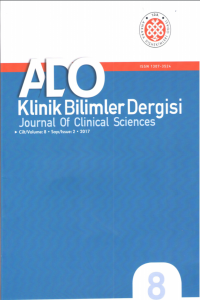Hidrojen Peroksit/Kolloidal Gümüş’ün Staphylococcus aureus Üzerindeki Etkisi: Pilot Çalışma
Hidrojen peroksit/kolloidal gümüş, Kontaminasyon, Staphylococcus aureus
The Effect of Hydrogen Peroxide/Colloidal-Ag on Staphylococcus aureus: A Pilot Study
___
- 1. Samaranayake LP, Fakhruddin KS, Buranawat B, Panduwawala C. The efficacy of bio-aerosol reducing procedures used in dentistry: A systematic review. Acta Odontol Scand 2021;79(1):69-80.
- 2. Coulthard P. Dentistry and coronavirus (COVID-19)-moral decision-making. Br Dent J 2020;228(7):503-5.
- 3. Weissman DN, de Perio MA, Radonovich LJ Jr. COVID-19 and risks posed to personnel during endotracheal intubation. JAMA 2020;323(20):2027-28.
- 4. Leggat PA, Kedjarune U. Bacterial aerosols in the dental clinic: A review. Int Dent J 2001;51:39-44.
- 5. Zelante F, Ashcar H, Piochi BJA, Monson CA, Cunha PS. Incidence of Staphylococcus aureus in mouth and nose of healthy individuals: Checking of identity among isolated strains. Rev Saude Publica 1982;16(2):92-6.
- 6. Wood C. Controversies in cross-infection control. Br Dent J 1993;174(7):249-51.
- 7. Jacks ME. A laboratory comparison of evacuation devices on aerosol reduction. J Dent Hyg 2002;76(3):202-6.
- 8. Crawford JJ. State-of-the-art: Practical infection control in dentistry. J Am Dent Assoc 1985;110(4):629-33.
- 9. Bagg J, MacFarlane TW, Poxton IR, Smith A. Essentials of microbiology for dental students. 2006. Retrieved from https://www.nature.com/articles/4813517.
- 10. Grenier D. Quantitative analysis of bacterial aerosols in two different dental clinic environments. Appl Environ Microbiol 1995;61(8):3165-8.
- 11. Francis JS, Doherty MC, Lopatin U, Johnston CP, Sinha G, Ross T, et al. Severe community – onset pneumonia in healthy adults can methicillin-resistant Staphylococcus aureus carrying the Panton-Valentine leukocidin genes. Clin Infect Dis 2005;40(1):100-7.
- 12. Shepherd PA, Shojaei MA, Eleazer PD, Van Stewart A, Staat RH. Clearance of biofilms from dental unit waterlines through the use of hydroperoxide ion-phase transfer catalysts. Quintessence Int 2001;32(10):755-61.
- 13. Tirali RE, Akça G, Bulut OE. The effects of the hydrogen peroxide colloidal-Ag on dental unit waterlines and waste waters. SOJ Microbiol Infect Dis 2016;4(1):1-5.
- 14. Rosenberg Goldstein RE, Micallef SA, Gibbs SG, Davis JA, He X, George A, et al. Methicillin-resistant Staphylococcus aureus [MRSA] detected at four U.S. wastewater treatment plants. Environ Health Perspect 2012;120(11):1551-8.
- 15. Syzmanska J. Biofilm and dental unit waterlines. Ann Agric Environ Med 2003;10(2): 151-7.
- 16. Dewhirst FE, Chen T, Izard J, Paster BJ, Tanner ACR, Yu WH, et al. The human oral microbiome. J Bacteriol 2010;192(19):5002-17.
- 17. Zmantar T, Kouidhi B, Hentati H, Bakhrouf A. Detection of disinfectant and antibiotic resistance genes in Staphylococcus aureus isolated from the oral cavity of Tunisian children. Ann Microbiol 2012;62:123-8.
- 18. Negrini TC, Duque C, Oliveira ACM, Hebling J, Spolidorio LC, Spolidorio DMP. Staphylococcus aureus contamination in a pediatric dental clinic. J Clin Pediatr Dent 2009;34(1):13-8.
- 19. Lineback CB, Nkemngong CA, Wu ST, Li X, Teska PJ, Oliver HF. Hydrogen peroxide and sodium hypochlorite disinfectants are more effective against Staphylococcus aureus and Pseudomonas aeruginosa biofilms than quaternary ammonium compounds. Antimicrob Resist Infect Control 2018;7:1-7.
- 20. Özalp M, Bulut ÖE, Ataç AS, Ekizoğlu M, Kart D, Çelik HH, et al. The effect of hydrogen peroxide/colloidal silver on reducing the colonization and growth of heterotrophic bacteria in dental unit waterlines. Turk J Biol 2013;37:336-41.
- 21. Cebrián G, Sagarzazu N, Pagán R, Condón S, Mañas P. Development of stress resistance in Staphylococcus aureus after exposure to sublethal environmental conditions. Int J Food Microbiol 2010;140:26-33.
- 22. Fox, A. (2016, March 03). Retrieved from https://www.microbiologybook.org/Turkish-bact/bactchapter13bturk.htm.
- 23. Lee J, Zilm PS, Kidd SP. Novel research models for Staphylococcus aureus small colony variants (SCV) development: co-pathogenesis and growth rate. Front Microbiol 2020;11:1-8.
- ISSN: 1307-3540
- Yayın Aralığı: Yılda 3 Sayı
- Başlangıç: 2006
- Yayıncı: Ankara Diş Hekimleri Odası
Hidrojen Peroksit/Kolloidal Gümüş’ün Staphylococcus aureus Üzerindeki Etkisi: Pilot Çalışma
Ayşe BULUT, Faik Serhat ÖZSOY, Gülçin AKCA, Nazime TUNCAY, Özgür Yıldırım TORUN, Ömer Engin BULUT
Farklı Akademik Dönemlerdeki Diş Hekimlığı Öğrencilerin Öğrenme Koşulları İle İlgili Tercihleri
Gökçen AKÇİÇEK, Şevket Murat ÖZBEK, Hatice Yağmur ZENGİN
ORTODONTİK ELASTOMERİK ZİNCİRLERDE OLUŞAN GERİLME DİRENCİ VE KUVVET KAYBININ DEĞERLENDİRİLMESİ
Kişiselleştirilmiş Diş Hekimliği
Sağ Maksiller Sinüste Gelişim Gösteren Radiküler Kist: Vaka Raporu
Merve ÖZARSLAN, Dilber BİLGİLİ CAN
Diş Hekimliği Öğrencilerinin İngilizce Öz Yeterlik Algısı ve İngilizce Bilgi Düzeyi İlişkisi
